We found interesting automotive display technology at Tier 1 suppliers and display companies such as LG Display, but there was surprisingly little in the way of display technolology to be seen at the North Hall booths of automotive OEMs themselves. The OEMs were focusing more on automotive connectivity, advanced driver assist systems (ADAS), and integration of vehicles and cities.
In part, this stems from a rapidly growing awareness that a significant part of the automotive future lies in electric vehicles that have significant awareness of the environments they are in, and that many of these vehicles will be shared and autonomous. That means not only that vehicles will come when you call them but that they will operate at a very high duty cycle, unlike the vast majority of personal vehicles today. That has major implications for the way in which vehicles are designed, built, and priced, and it is these considerations that are consuming automakers now.
There were displays in the cars, of course, but very little was said about the display technology itself for the most part. Most of the discussion was about how well the display integrated with voice, phone, accident avoidance, GPS, radar detection, and other systems.
So, let’s take a very quick tour of the automotive OEMs and some of of their component suppliers to get an idea of what they were and weren’t talking about.
Nissan‘s focus was on its Leaf battery electric vehicle (BEV), newly revised for 2018, and its “advanced Technology in Motion features.” Featured technologies included “e-Pedal, ProPilot Assist, ProPilot Park, and the Nissan Connect EV app.” There was digital signage in the booth, but you couldn’t see any displays intended to go in a vehicle.
Hyundai‘s interest was hydrogen fuel cell technology and its Nexo hydrogen vehicle, which will be available only in California in late 2018. While everybody else was looking at the drive train in a cutaway Nexo demonstrator, we were able to photograph the car’s dash, which includes a rather large, wide-aspect-ratio infotainment display. The dash and center stack are 2018-modern and appealing, but not awe-inspiring. The company was also promoting its Mobis electric power train parts.
Kia featured its Niro small hybrid CUV, which is economical, well-built, and not very interesting. A lot more interesting, and strange, was a concept incorporating a large display where you would expect the windshield to be, and similarly large displays in the driver and passenger doors. When both doors were opened, the driver and passenger were presented with a huge, three-part, Cinemascope-like display. Included in the concept was high-speed near field file transfer.
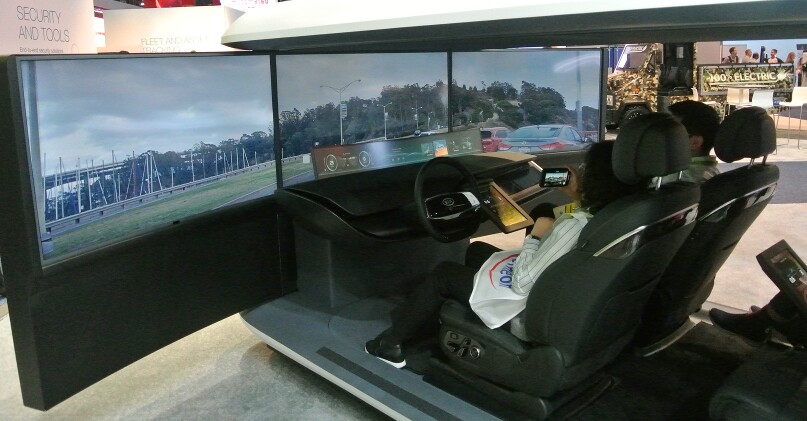 Caption: Strange but entertaining, Kia showed this very-wide-screen cockpit concept. (Photo: Ken Werner)
Caption: Strange but entertaining, Kia showed this very-wide-screen cockpit concept. (Photo: Ken Werner)
Honda showed no traditional vehicles at all, and therefore no vehicular displays. Instead, the company showed several robots for different applications, including the 3E-D18 robotic ATV.
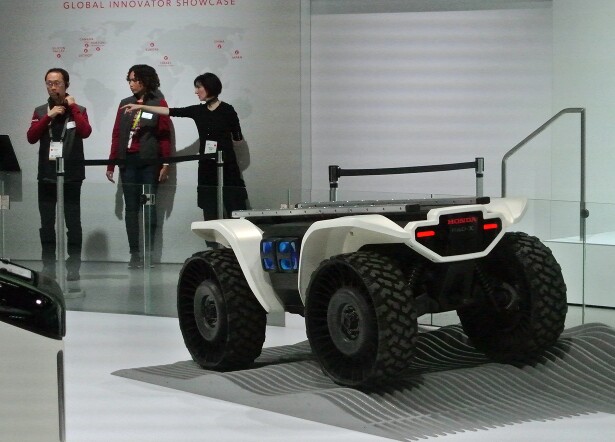 The closest thing to a car in Honda’s car-less exhibit was this robot all-terrain vehicle. (Photo: Ken Werner)
The closest thing to a car in Honda’s car-less exhibit was this robot all-terrain vehicle. (Photo: Ken Werner)
Gentex, which makes the digital rear-view mirrors that appear in some leading automotive brands, displayed its next-generation (v 2.5) “full display mirror.” As is common in such mirrors, the v 2.5 operates in either a mirror mode or display mode. Gentex claims a new ultra-thin design, new frameless technolgy, capacitive touch buttons for display adjustment and HomeLink control, and “all-new waterfall edge-to-edge display.” We did not get the chance to ask Gentex what the difference is between “new” and “all-new”. (we have good reason to believe that the Gentex display may have come from JDI – Man. Ed.)
 The new Gentex v 2.5 “full display mirror” is frameless, ultra-thin, and offers capacitive touch control. (Photo: Ken Werner)
The new Gentex v 2.5 “full display mirror” is frameless, ultra-thin, and offers capacitive touch control. (Photo: Ken Werner)
Denso, which announced itself as “crafting the core,” showed a cleanly designed cockpit concept, and didn’t say much about it.
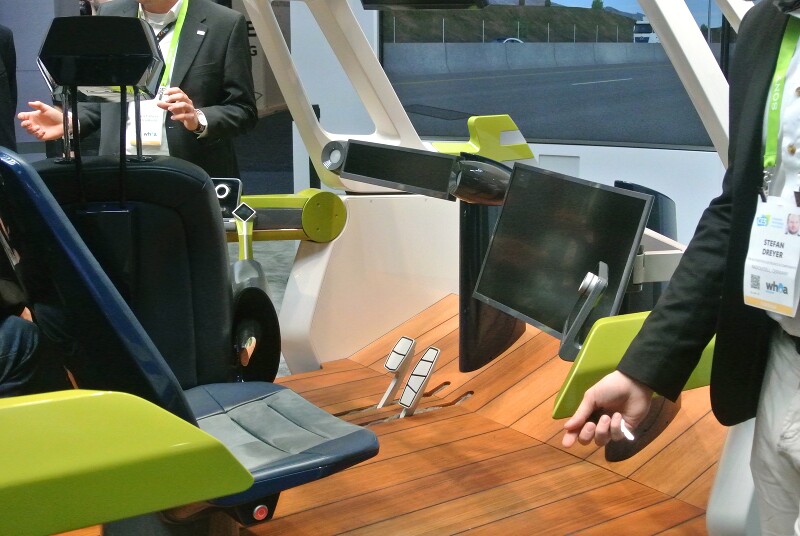
At the back of the booth, though, we found a curved OLED that Denso is aiming to get qualified for use in autos around 2020 or 2021. It is not yet qualified. The company was highlighting the better contrast than LCD, thinner form factor and curvability. Given that we have reported that Denso is considering investing in Joled of Japan, we assume that is where the display came from, but we cannot be sure.
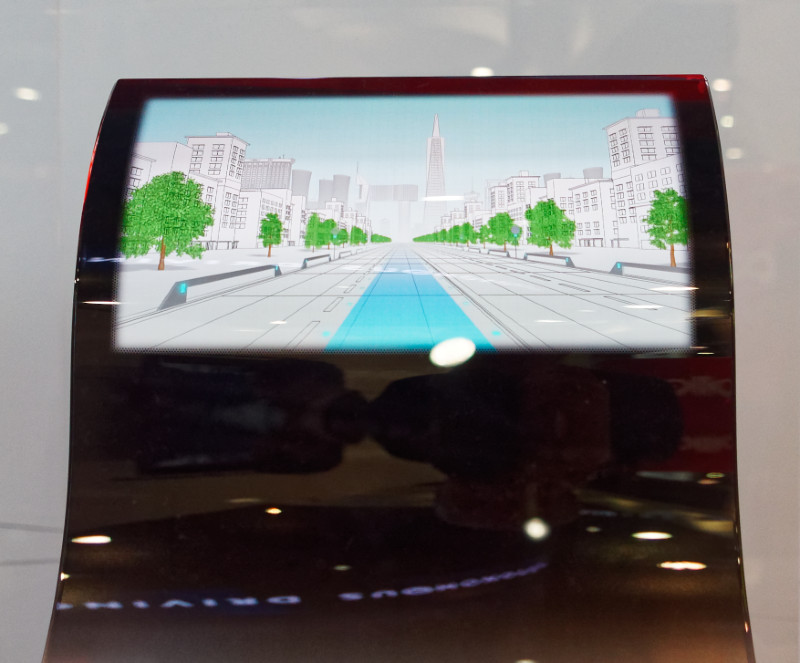 Denso showed this flexible OLED but didn’t give any details. Image:Meko
Denso showed this flexible OLED but didn’t give any details. Image:Meko
Delphi, the maker of automotive subsystems such as transmission control modules, engine controllers, and 48-volt mild-hybrid software, showed a Samsung display, but only to demonstrate the Dynamic Skip Fire (DSF) system it has developed with Tula. DSF is a very sophisticated cylinder deactivation system. While prior solutions have deactivated up to four cylinders, sometimes with annoying noise, vibration, and harshness (NVH), DSF decides how many cylinders to deactivate on every engine revolution, and also selects which combination of cylinders that should be for each revolution, thus dramatically reducing NVH, Delphi says.
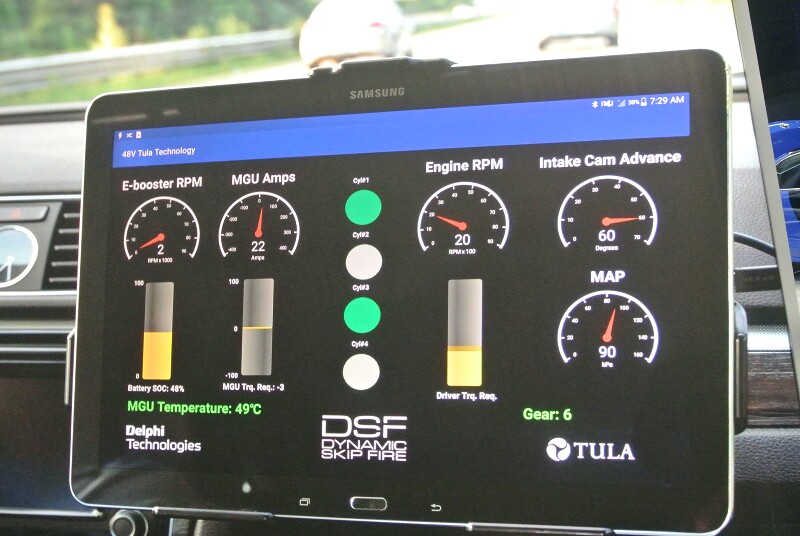 The Samsung display in Delphi’s booth was interesting for what it showed: engine data for the very smart Delphi/TULA DSF cylinder deactivation system. (Photo: Ken Werner)
The Samsung display in Delphi’s booth was interesting for what it showed: engine data for the very smart Delphi/TULA DSF cylinder deactivation system. (Photo: Ken Werner)
Who says a display has to be directed toward the driver and passengers of a vehicle? Although the idea of using an external display to to provide warnings or information to pedestrians and other vehicles is not new — Daimler showed such a system at CES two years ago — this year it was Toyota‘s turn to show off the idea in one of its Concept i-Ride concept vehicles.
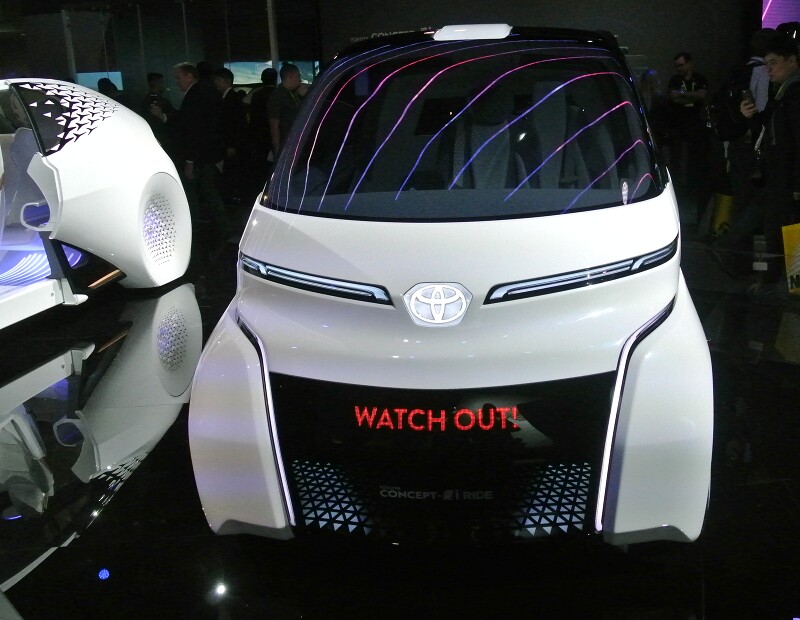 Displays don’t have to face the driver. They can also warn and inform pedestrians and other drivers, as in this Toyota Concept i-Ride vehicle. (Photo: Kenj Werner)
Displays don’t have to face the driver. They can also warn and inform pedestrians and other drivers, as in this Toyota Concept i-Ride vehicle. (Photo: Kenj Werner)
Pioneer featured a laser scan HUD build around its own compact RGB laser-scan projector module, a MEMS scanning mirror, and a Pioneer-developed ASIC. Pioneer claims high contrast ratio for good daylight visibility, wide viewing angle for complete coverage of left and right lanes. Illustrations suggested that the unit would occupy only a modest volume under the dash, which is a major design issue for HUDS sophisticated enough to support augmented reality (AR). Takeru Okada of Pioneer Electronics USA said the company expects the HUD to be in production in two years.
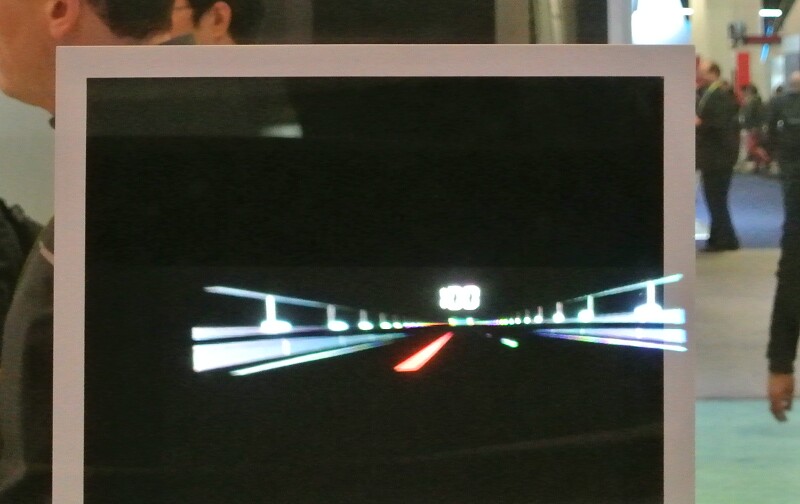 Pioneer’s laser scan HUD has impressive specifications, is relatively compact, and could be in production in two years. (Photo: Ken Werner)
Pioneer’s laser scan HUD has impressive specifications, is relatively compact, and could be in production in two years. (Photo: Ken Werner)
Also on display were flexible OLED lamps for automotive tail lights. Pioneer will provide the flexible OLED lighting film — which is being developed by Konica Minolta Pioneer OLED strategic partnership — to customers, who will integrate it into their own designs. Okada-san that OLED lighting products could appear in vehicles in three to four years “if customers cooperate.”
 Flexible OLED lighting film produced by Konica Minolta Pioneer OLED is being developmed for automotive tail lights. (Photo: Ken Werner)
Flexible OLED lighting film produced by Konica Minolta Pioneer OLED is being developmed for automotive tail lights. (Photo: Ken Werner)
In addition, Pioneer showed its “Advanced UX Cockpit” concept intended for Level 3 autonomous driving, in which the car drives itself under favorable conditions and passes control to the driver when conditions move outside the envelope deemed safe for autonomous operation. By my count, the cockpit contains five displays plus a laser HUD and a GoPro camera. The cockpit, says Pioneer, contains a driver monitoring system, facial recognition camera for condition and status of the driver, heart rate monitor, steering wheel sensor, seat sensor, and “seat vibration to improve level of alertness”.
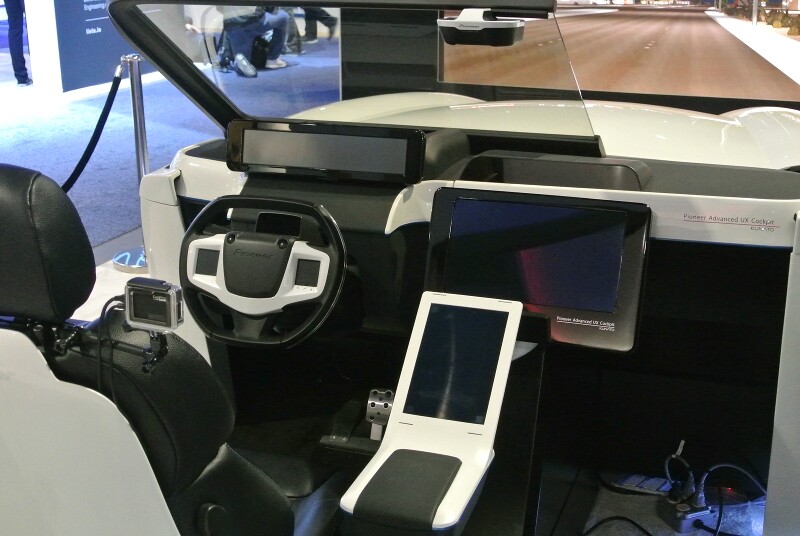 Pioneer’s Advanced UX Cockpit is intended to support Level 3 autonomous driving. (Photo: Ken Werner)
Pioneer’s Advanced UX Cockpit is intended to support Level 3 autonomous driving. (Photo: Ken Werner)
JVC Kenwood seemed proud of the new 6.95″ “clear resistive touch screen” that appers in its high-end Kenwood aftermarket receivers. The new screen has 1280 x 720 pixels compared to the previous screen’s 800 x 480; 16.7 million colors compared to 262 thousand; and a luminance of 600 cd/m² compared to 400; and a new anti-glare / anti-reflective treatment. The company claims “no change in color tone or brightness when viewed at an angle,” and presented photographs suggesting that was very much not the case with the previous display. Kenwood was promoting its ADS Maestro interface, which allows its receivers to access data from the automobile and aftermarket systems. In a “World’s First!,” K40’s custom-installed radar and laser systems interface with Kenwood receivers through the ADS, so detailed radar-detection information is presented on the receiver’s screen, and K40 functions can be controlled from the screen.
 Kenwood is offering an upgraded 6.95-inch display with 1280 x 720 pixels, 600 nits, enhanced anti-reflection, and clear resistive touoch on its high-end after-market receivers. (Photo: Ken Werner)
Kenwood is offering an upgraded 6.95-inch display with 1280 x 720 pixels, 600 nits, enhanced anti-reflection, and clear resistive touoch on its high-end after-market receivers. (Photo: Ken Werner)
In keeping with its old-school brand identity, the much anticipated 2018 Jeep Wrangler has a conventionally designed dash and displays. But with brilliant obviousness, the owner’s manual and a manual on off-road driving are accessible through the Uconnect touch screen. Modifications and additions are downloaded from the cloud. Are any other manufacturers doing this yet?
 In keeping with Jeep’s old-school heritage, the long-awaited 2018 Wrangler has a conservative-looking display suite. (Photo: Ken Werner)
In keeping with Jeep’s old-school heritage, the long-awaited 2018 Wrangler has a conservative-looking display suite. (Photo: Ken Werner)
Venerable mapping company Tom Tom Automotive showed a variety of aftermarket GPS units without mentioning their display technology or specs other than capacitive touch that permits user interaction with the navigation device via pinch, zoom, and swipe. The focus was on “automotive-grade navigation technologies,” including real-time maps with incremental map updating, and compressing 3D maps into 2D “or easier storage and faster processing.
Ford‘s impressive exhibit not only did show any automotive displays, it showed only two vehicles, and those just in passing. Ford’s entire exhibit was a display that created a partially real, mostly artificial cityscape that surrounded attendees, an environment Ford called the “living street.” “In the city of tomorrow,” said Ford, technology and ingenuity will combine to deliver a genuine sense of community and usher in an era where freedom of movement drives human progree that’s shared by all. This is where smart vehicles meet the smart world and create a system that helps people move more safely, confidently, and freely. In the past, roads may have been built for cars. In the City of Tomorrow, streets will be for living.” The concept includes dynamically selected loadinging and parking zones, including dynamic pricing.
 The display at Ford’s “Living Street” exhibit was the exhibit itself. The message: autonomous vehicles and smart cities will open the citiscape for people to enjoy. (Photo: Ken Werner)
The display at Ford’s “Living Street” exhibit was the exhibit itself. The message: autonomous vehicles and smart cities will open the citiscape for people to enjoy. (Photo: Ken Werner)
If this were a car article instead of a display article, I would open the section on Mercedes-Benz with the exciting Mercedes-AMG Project One “super sports car” that incorporates Formula 1 hybrid technology. Since it isn’t, I’ll lead off with the Mercedes-Benz User Experience (MBUX), the company’s new infotainment system that incorporates learning of user preferences via AI and can update itself with over-the-air downloads. The system includes intelligent voice control with natural speech recognition. The voice system is activated by saying “Hey Mercedes.” (I am not making this up.) Here’s the display part: it has a high-resolution widescreen cockpit with touchscreen operation, navigation display with augmented realilty. MBUX is not designed as a high-end solution. It will used in in M-B’s new generation of compact A-Class cars, the first of which will be introduced this year. M-B also showed a GLC with fuel-cell propulsion.
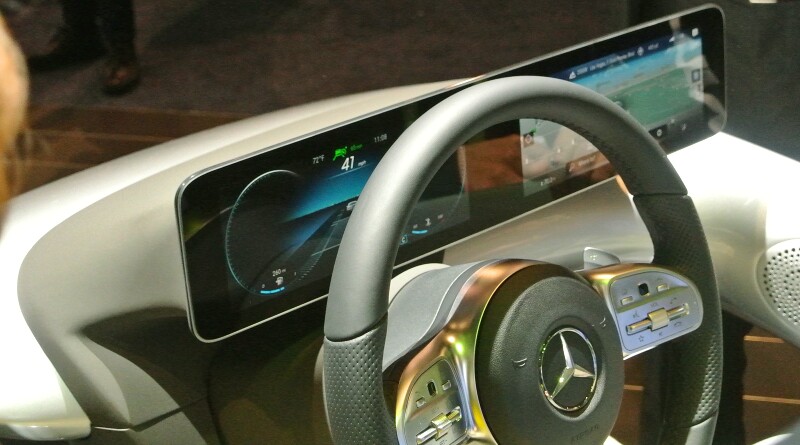 The Mercedes-Benz MBUX offers a wide-screen display that is both modern and modest, which is appropriate for its intended application in M-B’s new generation of compact A-Class cars. (Photo: Ken Werner)
The Mercedes-Benz MBUX offers a wide-screen display that is both modern and modest, which is appropriate for its intended application in M-B’s new generation of compact A-Class cars. (Photo: Ken Werner)
Like Harman and other Tier 1 suppliers, Bosch was demonstrating the integration of the instrument cluster and infotainment displays, which Bosch calls cockpit convergence. Examples included an integrated cluster for motorcycles and one for the Cadillac Escalade that personalizes vehicle settings and the HMI with a facial recognition camera, and uses smart voice recognition to allow the vehicle to identify who is speaking.
 Bosch showed this rather poorly integrated cockpit concept. The housing for the side-view camera is clumsy but interesting. (Photo: Ken Werner)
Bosch showed this rather poorly integrated cockpit concept. The housing for the side-view camera is clumsy but interesting. (Photo: Ken Werner)
ZF which is a Tier 1 supplier to the industry, was showing its Concept 2020 that is designed to reduce accidents and make drivers less stressed. Drivers renting cars often have problems with features because usage of many features is not intuitive. Comfort and safety functions tend to work separately , and control elements and indicators are located in different places, such as the warning signal on the exterior rear-view mirror, the switches on the indicator lever, icons in the cockpit or the LED display on the central console. ZF has worked with the fka GmbH research company to develop a simplified cockpit.
Uwe Class, project manager for “Concept 2020” at ZF, commented:
“Airplane pilots have had image displays such as artificial horizons for almost 100 years and still use them today. This helps them to capture a huge amount of information efficiently, and this technology will also be used to help car drivers in the future. The steering wheel, for instance, is designed without a lower and upper rim, so that it looks more like an airplane yoke.”
The concept is for Level 2 cars and features include modification to the displays to show the level of sensitivity of the control system and can adjust the seat belt if a collision seems likely or agitate it to alert a driver if action is required.
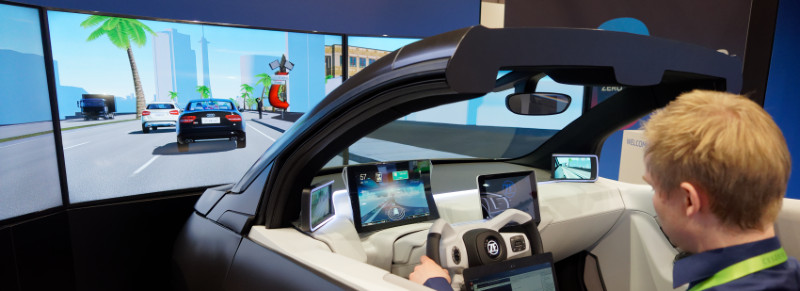 ZF’s Concept 2020 is for level 2 automation and is designed to reduce driver stress. Image:Meko
ZF’s Concept 2020 is for level 2 automation and is designed to reduce driver stress. Image:Meko
Valens the chip company behind HDBaseT, told us some time ago that it was aiming at automotive applications as its ability to deal with a wide range of signals in a single UTP cable was a compelling proposition for automakers. (16 Valens Pushes HDBaseT into Industrial PCs – Autos Next? and HDBaseT Takes Aim at Automotive with Multistream). Now the company is in mass production and told us that it has business with Daimler. It was also showing that its technology can be used to transmit PCIe data around cars.
We spotted this HUD in the CES Innovations Award area and found it was from Futuris Technology which is supplying it into the aftermarket.
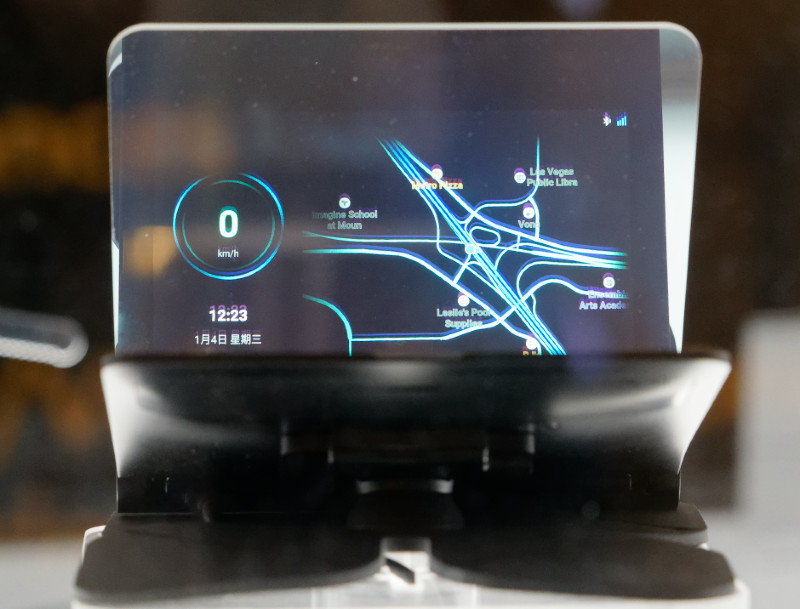 The Futurus HUD was shown in the Awards area. Image:Meko
The Futurus HUD was shown in the Awards area. Image:Meko
Glass maker, AGC was showing special glass that is infrared transparent and was being used to show how when this glass is used, Lidar systems can be mounted behind windscreens, eliminating for roof-mounted boxes. The company told us that the glass is also used by FlatFrog in some of its touch systems.
Panasonic, which is a leading Tier 1 supplier both to automotive OEMs and aircraft manufacturers, was showing its “smart design cockpit,” which combines high technology with premium materials. The cockpit incorporates a high-performance graphics engine that simultaneoously controls four multi-displays. Controls are touch activated, and “smart materials” allow surfaces like wood, leather, fabric, and stone to support capacitive touch and backlit graphics. The cockpit is designed for semi-autonomous vehicles. (however for some reasons why this concept may not come to pass see our report from the Faurecia press event (Faurecia’s Press Event Emphasises Health and Safety))
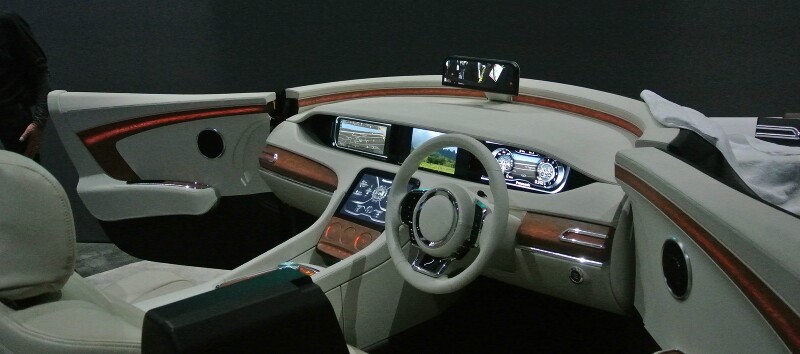 Panasonic’s Smart Design Cockpit offers superb display integration, luxurious materials, and smart touch surfaces where you wouldn’t expect to find them. (Photo: Ken Werner)
Panasonic’s Smart Design Cockpit offers superb display integration, luxurious materials, and smart touch surfaces where you wouldn’t expect to find them. (Photo: Ken Werner)
In its by-invitation-only suite LG Display was showing automotive displays, along with many other displays we describe elsewhere in Display Monitor. LGD’s focus was on plastic OLED (pOLED) and low temperature polysilicon (LTPS) backplanes for pixel densities over 200 ppi in displays up to 16.2″, for now. One cockpit demo featured a nice presentation of the sideview “mirror” displays on the large cluster display, making other solutions that make use of separate displays for the side views look clunky by comparison. An alternative concept mentioned by other suppliers is to use a flexible display on the A pillar for this application, which would result in the driver looking in approximately the same direction he or she does now for the side view.
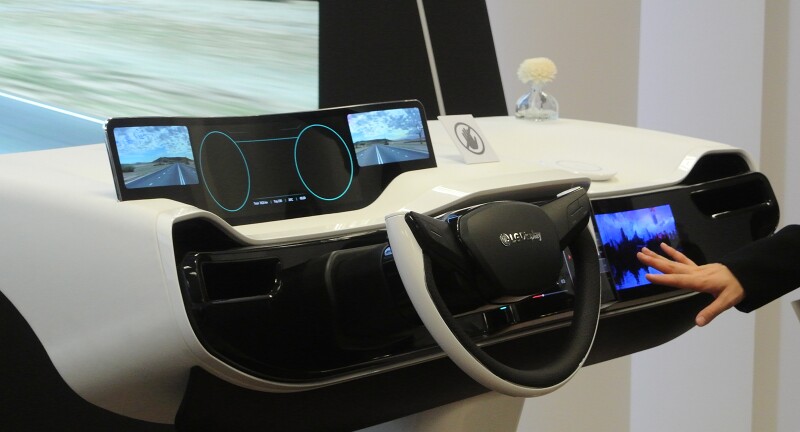 This LG Display cockpit concept is notable for the nice integration of the various displays and the positioning of the side-view images on the same display as the instrument cluster. (Photo: Ken Werner)
This LG Display cockpit concept is notable for the nice integration of the various displays and the positioning of the side-view images on the same display as the instrument cluster. (Photo: Ken Werner)
And even the $11,900 Arcimoto 80 miles-per-hour (130kph), 3-wheeled electric vehicle gets a display of its own. It’s not a “wide-cockpit concept” but ihe Alpha prototype display seen at CES was a 7″ TFT display with 800 x 480 pixels, a resistive touch overlay, 800 cd/m², and 16-bit color. Volume manufacturing for Arcimoto’s “fun utility vehicle” (FUV) will ramp up during H1’18 in Eugene, Oregon. The production display will be upgraded, probably to multi-touch capacitive touch, 1000 cd/m², and 24-bit color. — Ken Werner/ Bob Raikes
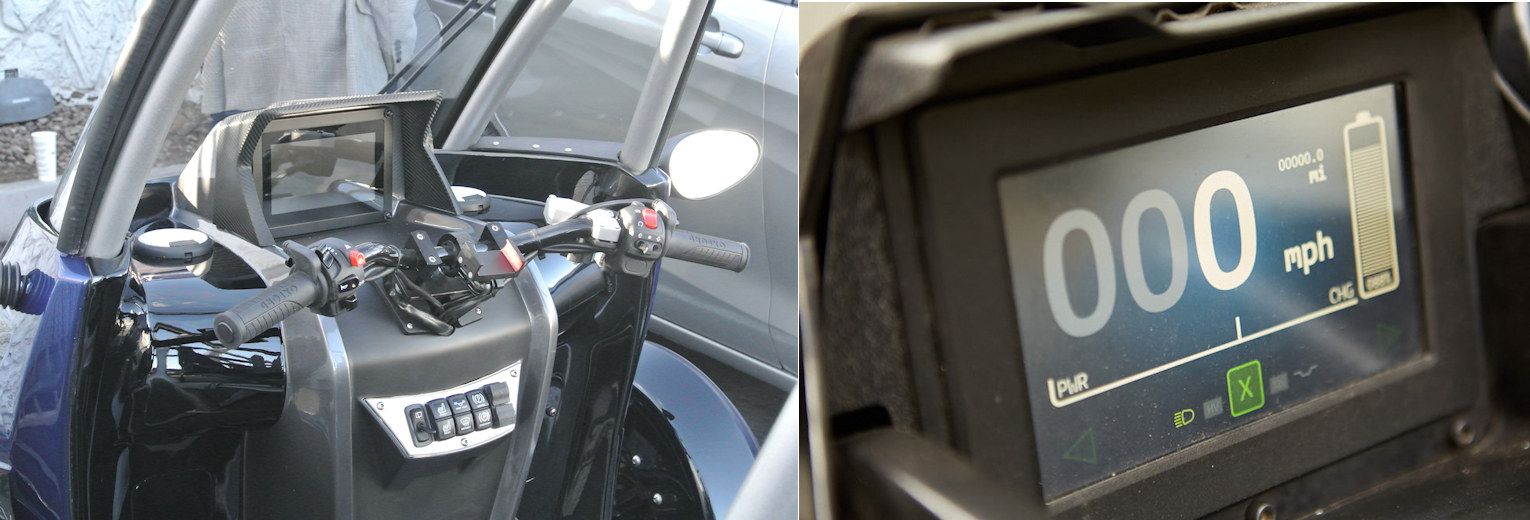 Even the $11,900 Arcimoto FUV (left) gets a digital cockpit display (right). (Photo credits: Ken Werner (left photo), Arcimoto (right photo) – click for higher resolution
Even the $11,900 Arcimoto FUV (left) gets a digital cockpit display (right). (Photo credits: Ken Werner (left photo), Arcimoto (right photo) – click for higher resolution
Byton was generating a lot of buzz. Family illness caused a delay in the report from our reporter that was writing about them, so we’ll follow up when we can. However, here is a picture of the amazing touch dashboard that was on show in the North Hall, for now. If the company can do what it wants, it could be very interesting! The display was claimed by BOE who said it has aresolution of 3840 × 720 and a brightness of 1000 cd/m².
 Byton’s full width touch dashboard concept. Image:Meko
Byton’s full width touch dashboard concept. Image:Meko

